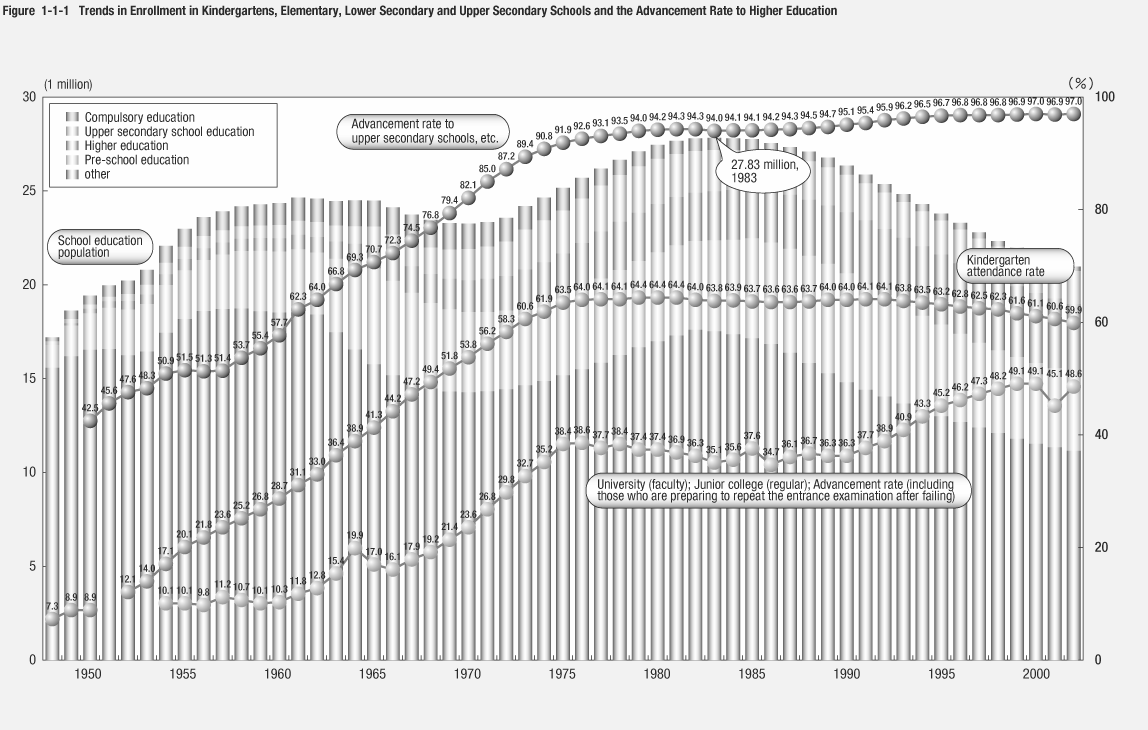| Home > Policy > White Paper, Notice, Announcement > White Paper > Japanese Government Policies in Education, Culture, Sports, Science and Technology 2002 >Chapter1 Section1.1 | ||
After the war, under the Constitution of Japan, important education laws, such as the Fundamental Law of Education and the School Education Law, were established and a new education system espousing respect for individual dignity and equal educational opportunity as its main ideals was created. Under the new education system, secondary education was divided into 3-year lower secondary education and 3-year upper secondary education and the so-called "6-3-3-4 system" of 6 years of elementary school, 3 years of lower secondary school, 3 years of upper secondary school, and 4 years of university was adopted. The length of compulsory education was extended to 9 years of elementary and lower secondary school. Thus a single track format of the school system was adopted to provide uniform education to all citizens. This was designed to ensure the realization of equal educational opportunities and to maintain and enhance the educational standards of citizens.
The new educational system had to begin under very difficult conditions immediately after the defeat in war. However, as regards compulsory education, by the middle of the 1950's, the new system was settled and nationwide access to education was secured at an acceptable level, supported by people's enthusiasm for education and efforts by people involved in education. Securing salaries for teachers was an extremely important problem and was one of the big burdens on local government financing. In the circumstances, a movement asking for national government financing of teachers' salaries was activated, and a system for the national treasury to bear one half of teachers' salaries, etc. was established. Other measures were also taken, such as financial assistance for pupils from poor families to attend school and provisions to promote education in isolated areas. Furthermore, systems of the national treasury to fund educational facilities and free provision of textbooks in compulsory education were established. Thus, the compulsory education system up to lower secondary school has been established.
Upper secondary education also expanded rapidly during the period from the mid l950's to the mid 1960's in line with the rapid growth of the Japanese economy. Part-time and correspondence courses started primarily to ensure opportunities for working youth and adults to participate in upper secondary education and, by the middle of the 1970's, more than 90 percent of the age cohort came to be enrolled in upper secondary schools. Although secondary education schools were for only a limited number of people before the war, the upper secondary schools have come to be a place to learn for almost all citizens in a short period of time after the war.
As for education of those who are mentally or physically handicapped, schools for the blind and for the deaf were made compulsory in FY 1956. Schools for those with other handicaps were included in compulsory education in 1979, after they had been steadily improved. And as for those pupils who have difficulties in commuting to school, "visiting education" has been implemented to provide educational opportunity.
The School Education Law defines kindergartens as schools for children who are not younger than 3 years old and have not reached the elementary school age. Kindergartens have been systematically improved and, by around 1965, the percentage of 5-year-old children commuting to kindergarten came to about 60%.

| Back To Top | MEXT HOME |